It was coincidence, or just a moment when we both were very open to new encounters, Angelika and I met in September 2023, while on our way to an art fair in Vienna. I remember that, among others, I got curious about the unconventional PhD she is doing at Kunstuniversität, in Linz, Austria. A research that aims at answering the question: «What does the world look like, when seen from a ship?». Wienerroither is interested in understanding what happens when we leave a stable land to travel on the surface of a fluid and metamorphosing sea. Thus, she investigates the world from her intimate perspective, using her own bodily experiences, her thoughts, and feelings as data for this exploration. Her ideas are materialised into installations, paintings, photography and text.
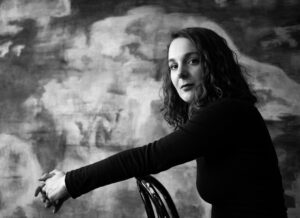
Angelika Wienerroither, portrait. Ph. Anna Marina Ernst
Erka Shalari: Since meeting you, I have started seeing water differently. What sparked your fascination with this element?
Angelika Wienerroither: I grew up next to a lake. My early childhood memories are connected to water: I spent endless summers swimming towards the raft surrounded by water, jumping in, head-first, diving underneath the barrels that held the wood afloat. The sun was shining through the wood, colouring the water in shades of light green, dark green, and somewhat yellow. I do not have a memory of the first time I saw the sea, but I remember a strong longing, and the wish to say goodbye when travelling inland again. When I feel stuck, I look for water. Something inside me starts to move again, when I am close to a lake, a river, the sea: I am in flow.
When one is in a flow, the same does not work towards an abjective. What do you think about unpredictability?
I am interested in how things evolve, how they manifest themselves. «The great image has no form» goes a Chinese saying. The fixed image is dead. I search for the “not yet become”, something still fluid. I have a strong Forschergeist (instinct), I am curious and I like to alter works when exhibiting them again. I am always thinking in installations, so I add, remove, combine, depending on the space. Unpredictability is also part of my process: there is always room for coincidence. I work with egg tempera, a very old technique combining water, linseed oil and egg. It takes six weeks to dry completely, during this time the colours change. The process is also one of layering, colour layer after colour layer, on one point of the canvas many, on others just a few. I am actually building the picture, but it feels like an archaeological process: I am digging out something and never know what I will find.
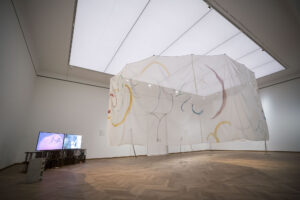
Angelika Wienerroither, “Rite of passage”. Ph. Helmut Graf, courtesy the artist
What do you think of the word “materiality” concerning the art field?
I love to play with materiality. For the series “Rite of passage–on motherhood”, which deals with Hannah Arendt’s concept of natality, I painted translucent textiles. I like to touch the delicate material, and I love that I can glimpse through while also being able to see the painting on it, this creates different layers of perception. In the same way, I am also very much drawn to the heavy and thick canvases. However, I never frame them, and most of my works are enormous. I like to install them in space, either hanging them from the ceiling or building wooden constructions. I look for the feeling of immersion the installation creates. Besides, it is easy to transport that way. I hardly ever simply hang framed paintings on the wall. This just bores me.
You also mentioned that you like to exhibit in abandoned houses, would you like to tell more?
I am interested in the flow of time and the traces of its passing, so I am especially drawn to abandoned houses. I love installing my work in such spaces, as they give me a lot of freedom. My first solo exhibition was in an Arbeiterhaus, a small building where the mill’s employees can sleep, wash themselves, cook. I left a photograph there: after the exhibition, a wrecking ball demolished the walls, and with them the artwork was destroyed together with the bricks that once held it upright. Those strong bricks were giving out their power and got destroyed like all other things. I also like to mention an exhibition of mine that I presented in an old brewery: here I installed 16 photographs showing the passage of time on the high walls. The glue I used for the installation was strong, so when I tried to remove them, parts of the plaster crumbled down. You can still see the marks of my pictures on the wall. I guess I like to leave something behind.
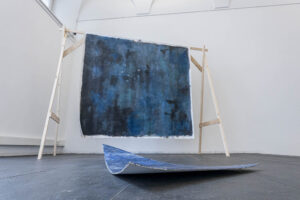
Angelika Wienerroither, “Oceanic”. Ph. Michael Klimt, courtesy the artist
Today, many artists have more than one medium: how is it for you?
I like to explore a topic in a prismatic way, looking at it from different angles, through different materiality. Hence, the medium strongly depends on how visitors shall feel when entering the installation. I really love working in my darkroom, it feels like being in a spaceship in outer space, out of time. I love the smells, the counting and the moment when the picture appears. I love the excitement when I turn on the light to see whether it all worked out. Photography, however, always relates to reality. You cannot capture something that is not there, that is not stroked by light. That is why three years ago I realised that I am very much drawn to painting. My topic of fluidity, dreams and memories has something outer-worldly, that I can only materialise with painting. I still go back to analogue photography, but more in the sense of memories: I search in my archive for photographs I may use.
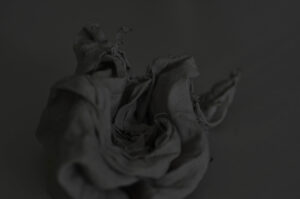
Angelika Wienerroither, “Jetlag”. Courtesy the artist
What themes come to the surface in your art?
In Greek there is a word for a special momentum, a chance that one should not let pass: kairos. In contrast to chronos, which is the normal flow of time, kairos is a tipping point, the moment when something changes. I have always been drawn to these tipping points, the only moment full of presence, when everything in your body yells: «Now!». In my work there is always a momentum of the “not yet become”, about how things might transform. I am interested in the in-between, the fluid, the metamorphosis. I am interested in the process, and the moment of change. There is another Greek word that draws me in: peírata. Thales, the first known philosopher, said that everything comes from water. His student, Anaximander, claimed that formless prose was the best way to describe this fluid world. But we are not lost. The formless is formed for a short time in peírata, thresholds, junctions, marks… I guess I have always searched for those peírata in art and life. My artworks are, for me, artefacts of those thresholds, materialised peírata in the flow of life or manifestations of inner states.
Concerning inner states, you also mentioned Lauren Fournier and her book “Autotheory as Feminist Practice in Art, Writing, and Criticism“, has this reading changed your way of thinking?
With autotheory came an important word, which is in English just a letter: “I”. I have begun to release my mistrust against the “I”. What I have to say is important, my being in this world is relevant. To theorise through one’s own experiences, combined with literature and writings of others, is a strong feminist practice: to include the framing of oneself being in this world. How knowledge is created is always dependent on the thinker, on the location, on the surroundings. Nothing is ever objective and trying to evoke that is impossible, just a lie. Autotheory opens the range of thinkers, biographies. It questions the «how this is done» and adds additional facets to science. After reading this book, I started to include my observations, and my encounters in the PhD, I also documented how my thoughts evolved, showing the process. I like to think about ways of introspection: how do I keep those tiny but precious moments in life? How not to lose them in the flow of time?
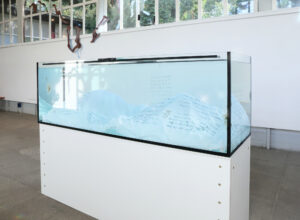
Angelika Wienerroither, “Fluid manifest”. Ph. Christian Ecker, courtesy the artist
The last question: what are your projects for 2024?
As in my PhD project I research how the world looks when seen aboard a ship, I decided I had to step onto a sailboat. In spring, I will sail the Norwegian passage from Tromsø, in the Lofoten islands, to Longyearbyen, in the Spitsbergen islands. I will spend eight days on the ship and travel 600 nautical miles. I will see water all day and night. And I hope to see the magic northern lights.
Erka Shalari
Info:
Angelika Wienerroither
wienerroither.photo
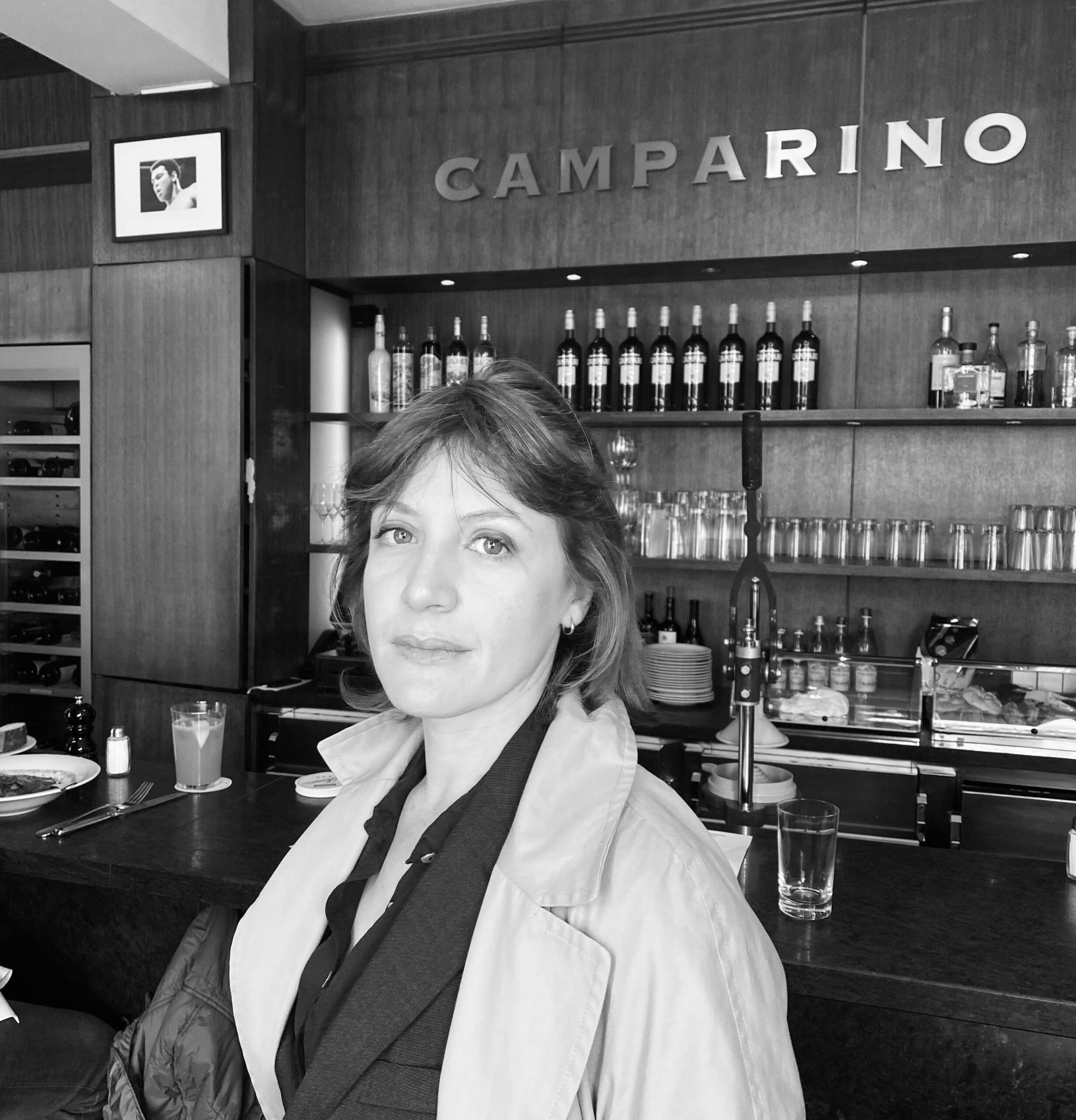
Erka Shalari is a Vienna based art writer and editor. Her work is committed to uncovering distinctive artistic positions in contemporary art. The work methodology is strongly influenced by psychology, epistemological works, as well as affects and rituals.






NO COMMENT